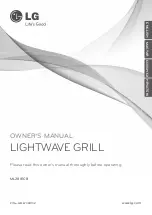
10
EXTENSION CORDS
Use proper extension cords. Make sure your extension
cord is in good condition and is a 3-wire extension cord
which has a 3-prong grounding type plug and a 3-pole
receptacle which will accept the tool’s plug. When using
an extension cord, be sure to use one heavy enough to
carry the current of the machine. An undersized cord will
cause a drop in line voltage, resulting in loss of power
and overheating. Fig. 20, shows the correct gauge to
use depending on the cord length. If in doubt, use the
next heavier gauge. The smaller the gauge number, the
heavier the cord.
Fig. 20
MINIMUM GAUGE EXTENSION CORD
RECOMMENDED SIZES FOR USE WITH STATIONARY ELECTRIC TOOLS
Ampere Volts Total Length of Gauge of
Rating Cord in Feet Extension Cord
0-6 120 up to 25
18 AWG
0-6
120 25-50 16 AWG
0-6 120 50-100 16 AWG
0-6 120 100-150 14 AWG
6-10 120 up to 25 18 AWG
6-10 120 25-50 16 AWG
6-10 120 50-100 14 AWG
6-10 120 100-150 12 AWG
10-12 120 up to 25 16 AWG
10-12 120 25-50 16 AWG
10-12 120 50-100 14 AWG
10-12 120 100-150 12 AWG
12-16 120 up to 25 14 AWG
12-16 120 25-50 12 AWG
12-16 120
GREATER THAN 50 FEET NOT RECOMMENDED
STARTING AND
STOPPING DRILL
PRESS
The switch (A) Fig. 21, is located on the front of the drill
press head. To turn the drill press
“ON”
move the switch
to the up position. To turn the drill press
“OFF”
move the
switch to the down position.
LOCKING SWITCH IN
THE “OFF” POSITION
When the tool is not in use, the switch should be locked
in the
“OFF”
position to prevent unauthorized use. This
can be done by grasping the switch toggle (B) and
pulling it out of the switch, as shown in Fig. 22. With the
switch toggle (B) removed, the switch will not operate.
However, should the switch toggle be removed while the
drill press is operating, the switch can be turned
“OFF”
once, but cannot be restarted without inserting the
switch toggle (B).
Fig. 22
B
Fig. 21
A
Содержание 11-990C
Страница 15: ...15 NOTES...


































